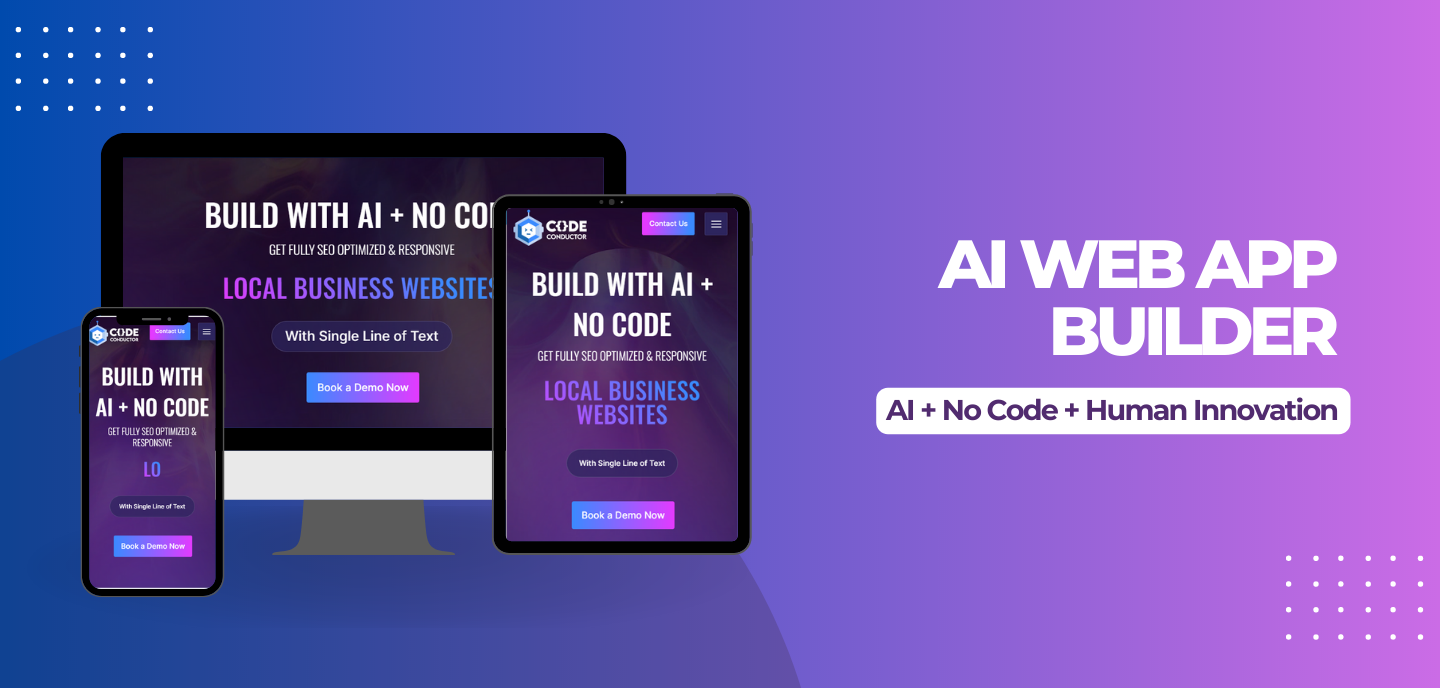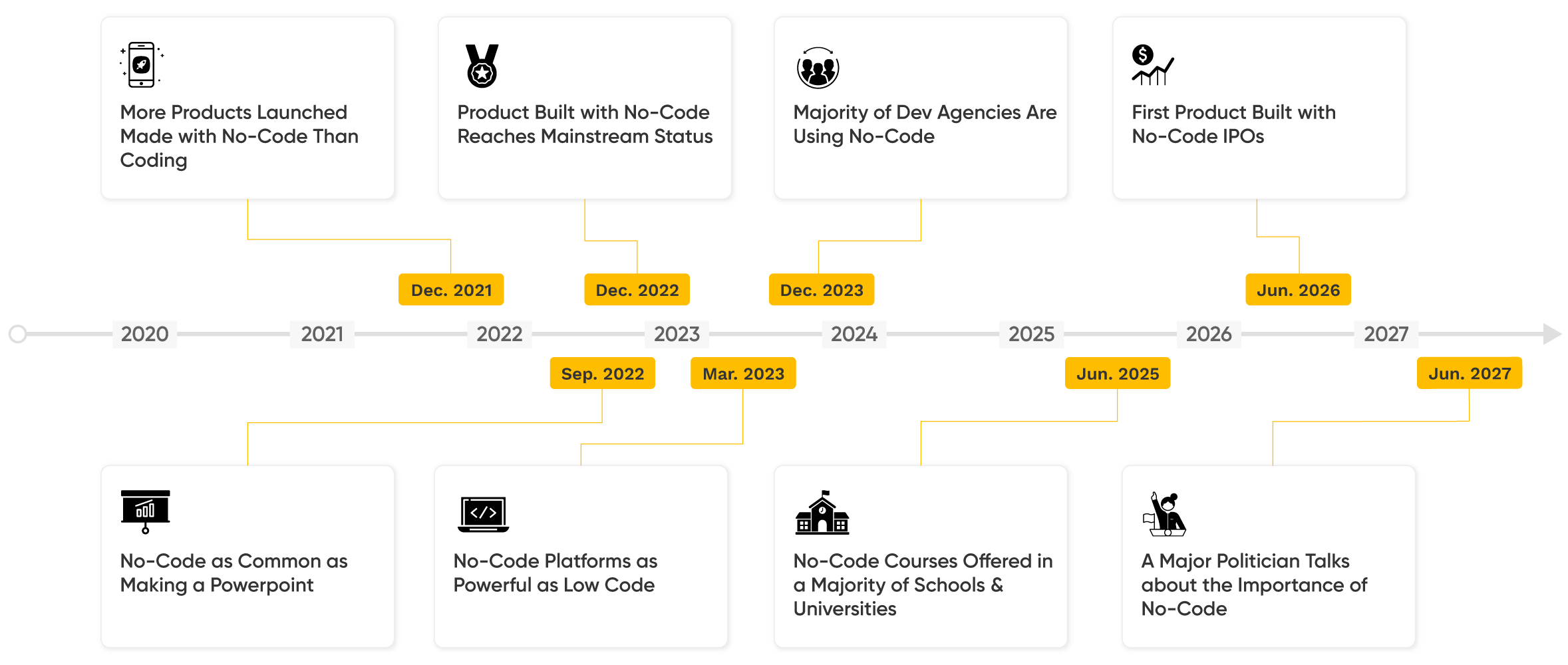Now a days, data suggests low-code/no-code tools are actually opening doors for such non-developers. 60% to 70% of companies said non-developers in their company already build tools for internal business use, and nearly 70% – 80% predict to see more of this trend in 2023.
There is a saying,” Change is inevitable” and so is the massive disruption in the ways we do the coding. As working from home is becoming the next working culture. The following questions keep wondering in the minds of programming experts:
1. How to make programming practices easy?
2. How to develop a no-code language that can work efficiently for mobile and web apps?
3. How to reduce the programmer’s job?
4. How to develop apps with minimum resources?
5. Why is there no code?
6. How can I make a program without coding?
In our previous post, we have covered 20 best nocode development platforms & tools list 2023. These platforms or tools can help you build and automate your next startup without writing a single line of code.
All these questions and similar thoughts have given birth to the new trends of no-code development.
A phenomenal change is brewing within the software programming ways that have completely reversed the programming practices.
One of the transformative innovations of 2023 is the use of no-code and low-code languages in developing robust applications.
The pandemic situation demanded a standalone practice that is cost-effective and makes the programming easy for people who are not from a programming background.
Small and midsize businesses (SMB’s) are especially adapting to this new programming style. Instead of conventional programming, using graphical user interfaces and tough configuration, no code is competitive and simple.
With the start of 2023 where everyone is thinking of gearing to make a kick start of their business. Let’s take a look at some of the biggest low-code trends that will significantly shape the programming ways!
Contents
What is NO Code Development?

Software development requires skills and proficiency along with time. After a lot of hard work, an application is built, and to run that app, certain hardware and software specifications are to be followed.
Looking at the practical challenges, the experts of programming innovated no-code platforms. It understand the logic behind the app and provide GUI to create the app.
This new way can create faster and functional apps. That’s the simple reason for becoming no code a popular platforms.
Future Generation Apps = Virtual Accessibility = Ready Made Apps= No Code (GUI)
The software coding was initially done by the mathematicians, then slowly programmers started mastering the software languages. By mastering one or two software languages, one can efficiently create software. Now platforms like WordPress or Squarespace allow non-coders to build websites.
And with no-code business platforms can be integrated. This is what “no-code” does for programming.
How Do No Code Application Platforms Work Faster?

No-code application platforms are a new, dynamic programming platform, and we can expect a lot of change over the next ten years.
When it comes to code fast, for developers many tricks and tips are available on the internet.
The basic principle divides the coding process into three parts, code, compile, and execute. In every new language and with the use of advanced technology like AI, the programming experts are working on these three principles separately.
As programmers say, programming is “self-experience”, yet there can be creative ways that will reduce the manual work and execution of code.
The no-code language makes use of the ready to compiled drag and drop components. It is used in creating web pages and apps.
Since the elements are already compiled and executed. The time is saved and the process can be faster.
However, the basic knowledge to insert the elements is required. Some developers ways for making no code fast apps are:
Analysis: The first step developers do is to check what they need to build. And, how much is already available?
Design/Implementation: A visual programming interface to drag-and-drop pieces into place is chosen that reduces the coding time.
Testing: In the meanwhile, the testing of the app is done to make adjustments with just a few clicks.
Release & Maintenance: A quick-release is done and changes are implemented if they are needed.
This way a focus is shifted from a sound programming practice to a better user experience.
It is not only providing fast ways to develop apps rather the shortage of expertise in programming can also be overcome.
Why is No code Application Development Prevalent?

No-code application development can be considered as the extension of low code programming.
As already discussed, anyone without a sound programming background can use no-code platforms by being easy enough. While boasting capabilities powerful enough to build secure, complex, enterprise-grade applications.
Most of the no-code platforms are ready to use drag and drop elements.
However, you also need to support JavaScript or HTML integrations for added customization. Fortunately, it’s agile in coding flexibility as in implementation.
The following key ingredients and features are added to it.
User Interface Builder
In building mobile and web apps, creativity and functionality go hand in hand.
Today’s programming platforms must support multiple platforms. It can be developed without hassles and in the fast development mode.
At the same time, it must have the capability to experiment with some adventurous changes in building a unique user experience.
No code is compatible to use with JS frameworks like Angular or Vue.js – for full freedom and flexibility.
Visual modeling and Re-usability
Visual modeling is the latest process and app management model. It is adopted for fast, fun, and easy programming with endless possibilities. It brings a shift in traditional programming as it believes in reusing the code.
The existing code is reused in such a way that it enhances the capabilities of elements. It is like an add on or extension to already developed apps that are commonly kept in a virtual space like the cloud.
Instead of programming individually, you just get access to the community that is having a common platform for all.
Integrations
A major shift that is adopted by web apps is the integration of different platforms and services. No code development allows you to integrate with all kinds of web services like Slack, Twitter, Mollie, or Ideal.
The platform fits into every IT landscape and provides modern possibilities for legacy systems. The apps become more generic rather than traditional ones.
Of course, traditional programming has a wide scope but for small enterprises, a common application is more useful.
What Kinds of Applications Can You Build Without Coding?

Normally, no code is implemented in three kinds of applications: Back office (database), Web, and Mobile applications. The coding platform is easy to run on the cloud.
Examples of applications can be found where even a single line of code is not done to build an application:
Back Office Applications
Administrators always find it hard to manage the back end operations. The applications available in different languages are complex and mostly designed to perform a particular function.
The no code is efficiently used to integrate the newly developed AI and ML-based apps with the existing database.
The custom software helps you maintain databases that are easy to integrate and handle even the large databases.
The no-code platform offers a grid view providing a feature like a filter, search, export, import, logic (workflows), and more.
The platform makes it easy to visually create grids, forms, and workflow without programming. And, It can increase the speed of the applications developed.
Portals and Web Applications
Need to customize your web applications? Use a no-code platform that provides a user interface with ready-made back-office features.
You can use your HTML or our WYSIWYG page editor or insert your favorite JS framework to build with. Also, the platform allows you to use style sheets.
As a developer, one can understand that no code provides an excellent opportunity for developers to speed up the development process by using ready-made components.
For generic applications and portals where a similar type of functionality is required, it is indeed a helpful tool.
Mobile Applications
No code allows you to build lightweight mobile apps that can be fully customized. The app can be integrated with a web-based interface allowing you to use all elements of the web browser without any software installation. The apps can be built using HTML, CSS, and JavaScript.
You can distribute it like a web app that will run on a mobile browser.
Important: Once you view the already built examples of web and mobile apps, you will have a clear idea to start your new app with no code. So, discover application building with no code. For exploring new possibilities while using no code, you can get in touch with our expert’s team.
Unleash Your Creativity with Code Conductor: A Powerful No-Code Platform

Code Conductor, a leading no-code development platform, empowers users to create sophisticated applications without writing a single line of code. With its intuitive drag-and-drop interface and a vast library of pre-built components, Code Conductor simplifies the app development process.
Whether you’re a seasoned developer or a non-tech entrepreneur, Code Conductor opens up new possibilities, enabling you to bring your innovative ideas to life effortlessly. Unlock your creativity with Code Conductor!
How Is No Code Software Implemented In The Enterprises?
We have been watching the growth of data storage as the trends of virtual platforms and distributive storage have taken the lead. To understand the use of a no-code platform, let’s consider an example of data storage.
We have great options like RDBMS software or simply an excel sheet. The process of storage is tricky and there are possibilities of human error.
The excel software is good enough for conducting mathematical functions, But for data storage, it’s not a good option.
The same is the case with any database software like SQL, or Oracle where you need skills to operate and store data.
Now coming back to the example we are discussing, suppose you need to store and share more than 10, 000 records in just 3-4 hours.
In this case, the database and excel like software will prove to be fragile as you need to create a separate application to run on the cloud.
The use of no-code will allow you to quickly develop a cloud-based application to store and access your data. As long as your requirements fit within the functionality of the system you chose, the no-code platform is a great solution to tackle human error.
The automated data entry can be done and within the specified time the data will up on the cloud.
So, in a way, we can say that the no-code platforms will shorten the gap between professional programmers and non-programmers. It is developed to maximize productivity in the workplace that will reduce the time needed to go from an idea to a fully working app. No code seems to be a perfect solution for MVP / POC products.
Some of the future trends that will make no code more popular are:
No Code: A new type of “builder”
As the trend of people, with no sound programming background, building their applications for business purposes is increasing. No – code is coming up as the “citizen development” method to build simple apps.
The new type of programming might not require syntax knowledge. But the general programming concepts must be clear like objects, variables, class, and application logic.
The interesting fact is that more business analysts are qualified to learn these skills than the developers.
Complexity expansion
No code programming includes basic to advanced level concepts like capturing an attribute in a form; performing an underwriting algorithm for an application, integrating an AI or Ml code with a simple app, and so on.
All you need to know is to incorporate application logic into the component architecture. Over time, components will become more functional and will be able to fulfill the business requirements. As a result, no-code platforms will get closer and closer to true “custom coding” flexibility.
More Agility and Innovation
If we examine the statistics of the big non-IT organizations, 60% of the budget is spent on providing the application to access organizational data and further to do its analysis so that it can produce effective results.
No-code application development will balance the budget by moving the mainstream development tasks to a no-code platform. The developers can then work with more focus on building applications that can reduce the cost and improve ROI.
No code is Cost-Effective Robust Solution
One of the long-term benefits of no code is its lesser maintenance cost than a traditional code-based project. The component-based model will reduce maintenance costs over time. In the long run, this will result in an “unlocking” of IT resources that will move the business forward at the rate of reduced cost.
At the same time, this type of programming goes along with advanced programming techniques such as AI, IoT, ML, and so on. The use will be more in building business applications that deal with data and statistics management.
As we have made clear above in the discussion that no-code development platforms use business-scale APIs to connect particular business systems and workflows. The new coding platform can be used to create changes in business applications on a daily basis by making use of filters and information queries. This way you can customize the applications.
They can then utilize APIs to combine data from different sources or applications smoothly.
Some of the enterprise’s usage of no – code are:
- A visual platform allows using drag and drop widgets or separate components. For create new apps or configure organizational workflows.
- The templated user-interface and ready-to-use functions for web forms, workflows, and data analytics.It will allow business applications to work more efficiently.
- The productive ideas will allow making changes in the running applications that go with the nature of business applications.
- The applications support cloud-based environments. So,the coding type will go a long way when it comes to creating custom applications.
Impact of No Code for Future Programming?
The innovation will greatly impact the IT leaders and tech departments. There will be a shift from conventional programming to a more governance-centric and supervisory role rather than dynamic software programming and debugging.

One of the transformational benefits will be the dependence on programmers will reduce . One will have the chance to become an application developer if he has the basic programming knowledge and understanding of business operations.
At the same time, the core programming areas will not be affected as they will continue to deliver as they are doing now. No code will no way replace the programming practices rather it will work as a parallel tool. And it will promote the business applications.
One of the big challenges that will come along is to maintain the security of the applications. For this, the dev community has already started working.
The new protocols will be introduced in the coming times. It will make things more transparent maintaining the sensitivity of applications.
Nevertheless, NCDPs have been anticipated as the next wave in programming and techniques for rapid app development, which could be revolutionary for the software world.
On a larger scale, the evolution of no code can be viewed as the beginning of the new era as it was before the GUI version of Windows came into existence. It changed the way we operate PCs and laptops.
The Dos commands were tough to understand and run for the common person. But clicking on the files and folders made Pcs a common man-machine.
The evolution of programming languages like c++, Python, JS platforms. These languages allowed the development of various types of applications.
Then some more languages got an entry which helped in making mobile apps.
Now, the developers believe that no-code coding. They will add robotic functionality in the field of software evolution.
Closing Words
When we talk about advanced programming techniques, no –code has a long way to go and a major role to play in the coming times.
However, more clarity on the use and development is yet to be derived. But in the future, we have to shift to a platform like no- code. It will help in developing faster, easier, and more efficient time-saving applications.
On the other hand, the traditional way of programming as discussed above will not completely perish. But they will be used in developing complex applications.
The market size of the no-code platform is going to generate a revenue of $187.0 billion by 2030, rising from $10.3 billion in 2019. It is further expected to advance by 31.1% CAGR, as predicted. Stay tuned with us to know more details on “ NO CODE PLATFORM”.
Also Read –
- 56 Marketing Tools + Resources To Increase Your Productivity
- Android Mobile App Development Roadmap 2023
- How to Deploy & Install Rancher on Kubernetes Cluster – Guide
- How To Become A Full Stack Developer In 2023?
- UX(User Experience) Design Process Stages

Director of Digital Marketing | NLP Entity SEO Specialist | Data Scientist | Growth Ninja
With more than 15 years of experience, Loveneet Singh is a seasoned digital marketing director, NLP entity SEO specialist, and data scientist. With a passion for all things Google, WordPress, SEO services, web development, and digital marketing, he brings a wealth of knowledge and expertise to every project. Loveneet’s commitment to creating people-first content that aligns with Google’s guidelines ensures that his articles provide a satisfying experience for readers. Stay updated with his insights and strategies to boost your online presence.
